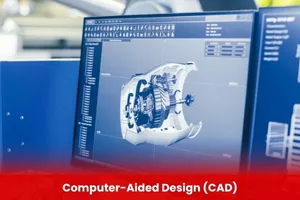Computer-Aided Design (CAD)
At BURAAQ UK, our Computer-Aided Design (CAD) program is designed to equip individuals with the essential skills and tools to create precise, professional, and industry-standard technical drawings and 3D models. CAD has revolutionized the engineering, architecture, and manufacturing sectors by replacing traditional drafting with digital design environments that improve accuracy, productivity, and collaboration.

Aim of Computer-Aided Design (CAD)
The aim of the Computer-Aided Design (CAD) course at BURAAQ UK is to equip learners with the practical skills and technical knowledge required to create accurate 2D drawings and 3D models using industry-standard CAD software, enabling them to meet the design and documentation needs of engineering, construction, and manufacturing sectors in compliance with international standards.
Course Overview
Computer-Aided Design (CAD)
- Educational Background
- Minimum Requirement:
- Completion of secondary education (GCSE, Matric, or equivalent)
- Preferred Background:
- Students or graduates of:
- Mechanical / Electrical / Civil Engineering
- Architecture / Interior Design
- Technical or vocational programs (e.g., BTEC, DAE, NVQ)
- Students or graduates of:
- Computer Skills
- Basic proficiency in using a Windows-based computer
- Familiarity with file handling, folders, and basic software operations
- Technical Interest or Experience
- No prior CAD experience required — course starts from the basics
- Ideal for those interested in:
- Drafting and technical drawing
- 2D/3D modeling
- Engineering or design workflows
| Course Code | Curriculum Title | Credit | DLH |
|---|---|---|---|
| BUK1388-1 | Introduction to CAD | 3 | 15 |
| BUK1388-2 | Fundamentals of 2D Drafting | 3 | 15 |
| BUK1388-3 | Dimensioning and Annotation | 3 | 15 |
| BUK1388-4 | Drawing Standards and Templates | 3 | 15 |
| BUK1388-5 | Introduction to 3D Modeling | 3 | 15 |
| BUK1388-6 | Project Work – 2D Drafting | 3 | 15 |
Module 1: Introduction to CAD
- What is CAD and its role in modern industries
- History and evolution of CAD tools
- Overview of common CAD software: AutoCAD, SolidWorks, Fusion 360, etc.
- Interface navigation and workspace customization
Module 2: Fundamentals of 2D Drafting
- Drawing tools: line, circle, arc, rectangle, polygon, etc.
- Object selection and editing tools: move, copy, trim, offset, mirror
- Layer management, color coding, and linetypes
- Grid, snap, and object tracking
Module 3: Dimensioning and Annotation
- Types of dimensions: linear, radial, angular
- Text and labeling standards
- Hatching and fills
- Working with scales and plotting settings
Module 4: Drawing Standards and Templates
- ISO and BS standards for technical drawings
- Title blocks, borders, and drawing templates
- Creating reusable drawing components (blocks and attributes)
Module 5: Introduction to 3D Modeling (Optional or Advanced Track)
- Basic concepts of 3D modeling (wireframe, surface, solid)
- Extrude, revolve, sweep, and loft tools
- Viewports, visual styles, and rendering basics
- Generating 2D drawings from 3D models
Module 6: Project Work – 2D Drafting
- Real-world drafting assignment (e.g., floor plan, machine part, electrical layout)
- Application of all 2D tools, layers, dimensions, and annotation
- Review and feedback on drawing accuracy and standards
Module 7: Project Work – 3D Design (Optional or for Extended Courses)
- Create a 3D model from a given sketch or concept
- Apply materials, lighting, and camera views
- Generate technical views (isometric, orthographic, sectional)
Module 8: Plotting and File Management
- Printing setup, page layout, and plotting to scale
- Exporting files (PDF, DWG, DXF)
- File naming conventions and folder structures
Module 9: Industry Applications and Career Pathways
- CAD roles in mechanical, electrical, civil, and architectural fields
- Portfolio building and project documentation
- Career guidance and software certification paths
- Students
- Technicians & Apprentices
- Professionals & Career Switchers
- Beginners in Design
- International Learners
- All Modules within this qualification are assessed internally by the approved training Centre and externally verified by BURRAQ UK. The program uses a criterion-referenced assessment approach to ensure that learners successfully meet all required learning outcomes.
- A Pass in any unit is granted only when the learner submits valid, reliable, and authentic evidence that demonstrates achievement of the assessment criteria. The Assessor is responsible for reviewing this evidence and confirming that the learner has attained the expected standard.
